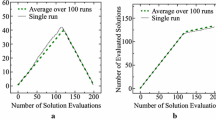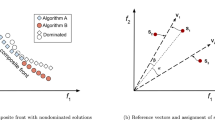Abstract
Interactive evolutionary computation (IEC) has a large potential ability as a personalized optimization technique to search for preferred solutions. In IEC, evolution of a population is driven by human user’s preference through his/her subjective fitness evaluation. As a result, different solutions are obtained by different users for the same problem. One important challenge in the design of an efficient IEC algorithm is to decrease the human user’s burden in fitness evaluation. We have proposed an idea of a (1+1)ES model of IEC with the minimum requirement for human user’s fitness evaluation ability under the following assumptions: (i) human users can evaluate only a single solution at a time, (ii) human users can remember only the previously examined single solution, (iii) the evaluation result is whether the current solution is better than the previous one or not, and (iv) human users can perform a prespecified number of evaluations in total. This model always has a single archive solution, which is used as the final solution when its execution is terminated. In this paper, we generalize the (1+1)ES model of IEC to a general (μ+1)ES model where μ is not a constant but a variable control parameter. More specifically, the value of μ is controlled so that only a single solution is obtained after the final generation (i.e., μ=1 at the final generation whereas μ can be more than one in the other generations). We show how we can derive the upper bound on the value of μ at each generation from the requirement of μ=1 at the final generation and the above-mentioned four assumptions. We also examine the search behavior of the (μ+1)ES model for various values of μ.
Access this chapter
Tax calculation will be finalised at checkout
Purchases are for personal use only
Preview
Unable to display preview. Download preview PDF.
Similar content being viewed by others
References
Dawkins, R.: The Blind Watchmaker. Norton, New York (1986)
Takagi, H.: Interactive Evolutionary Computation: Fusion of the Capabilities of EC Optimization and Human Evaluation. Proceedings of the IEEE 89(9), 1275–1296 (2001)
Kim, H.S., Cho, S.B.: Application of Interactive Genetic Algorithm to Fashion Design. Engineering Applications of Artificial Intelligence 13(6), 635–644 (2000)
Cho, S.B.: Towards Creative Evolutionary Systems with Interactive Genetic Algorithm. Applied Intelligence 16(2), 129–138 (2002)
Cho, S.B.: Emotional Image and Musical Information Retrieval with Interactive Genetic Algorithm. Proceedings of the IEEE 92(4), 702–711 (2004)
Lameijer, E.W., Kok, J.N., Bäck, T., Ijzerman, A.P.: The Molecule Evoluator. An Interactive Evolutionary Algorithm for the Design of Drug-like Molecules. Journal of Chemical Information and Modeling 46(2), 545–552 (2006)
Takagi, H., Ohsaki, M.: Interactive Evolutionary Computation-based Hearing Aid Fitting. IEEE Trans. on Evolutionary Computation 11(3), 414–427 (2007)
Arevalillo-Herráez, M., Ferri, F.J., Moreno-Picot, S.: Distance-based Relevance Feedback using a Hybrid Interactive Genetic Algorithm for Image Retrieval. Applied Soft Computing 11(2), 1782–1791 (2011)
Lai, C.C., Chen, Y.C.: A User-oriented Image Retrieval System based on Interactive Genetic Algorithm. IEEE Trans. on Instrumentation and Measurement 60(10), 3318–3325 (2011)
Avigad, G., Moshaiov, A.: Interactive Evolutionary Multiobjective Search and Optimization of Set-based Concepts. IEEE Trans. on Systems, Man, and Cybernetics - Part B: Cybernetics 39(4), 1013–1027 (2009)
Chaudhuri, S., Deb, K.: An Interactive Evolutionary Multi-objective Optimization and Decision Making Procedure. Applied Soft Computing 10(2), 496–511 (2010)
Deb, K., Sinha, A., Korhonen, P.J., Wallenius, J.: An Interactive Evolutionary Multiobjective Optimization Method based on Progressively Approximated Value Functions. IEEE Trans. on Evolutionary Computation 14(5), 723–739 (2010)
Kaliszewski, I., Miroforidis, J., Podkopaev, D.: Interactive Multiple Criteria Decision Making based on Preference Driven Evolutionary Multiobjective Optimization with Controllable Accuracy. European Journal of Operational Research 216(1), 188–199 (2012)
Sun, X., Gong, D., Zhang, W.: Interactive Genetic Algorithms with Large Population and Semi-supervised Learning. Applied Soft Computing 12(9), 3004–3013 (2012)
Ishibuchi, H., Hoshino, K., Nojima, Y.: Problem Formulation of Interactive Evolutionary Computation with Minimum Requirement for Human User’s Fitness Evaluation Ability. In: Proc. of 16th Asia Pacific Symposium on Intelligent and Evolutionary Systems, Kyoto, Japan, December 12-14, pp. 52–57 (2012)
Takagi, H., Pallez, D.: Paired Comparisons-based Interactive Differential Evolution. In: Proc. of NaBIC 2009, Coimbatore, India, December 9-11, pp. 475–480 (2009)
Fukumoto, M., Inoue, M., Imai, J.: User’s Favorite Scent Design using Paired Comparison-based Interactive Differential Evolution. In: Proc. of CEC 2010, Barcelona, Spain, July 18-23, pp. 4519–4524 (2010)
Zitzler, E., Thiele, L.: Multiobjective Evolutionary Algorithms: A Comparative Case Study and the Strength Pareto Approach. IEEE Trans. on Evolutionary Computation 3(4), 257–271 (1999)
Author information
Authors and Affiliations
Editor information
Editors and Affiliations
Rights and permissions
Copyright information
© 2014 Springer International Publishing Switzerland
About this paper
Cite this paper
Ishibuchi, H., Sudo, T., Nojima, Y. (2014). Archive Management in Interactive Evolutionary Computation with Minimum Requirement for Human User’s Fitness Evaluation Ability. In: Rutkowski, L., Korytkowski, M., Scherer, R., Tadeusiewicz, R., Zadeh, L.A., Zurada, J.M. (eds) Artificial Intelligence and Soft Computing. ICAISC 2014. Lecture Notes in Computer Science(), vol 8467. Springer, Cham. https://doi.org/10.1007/978-3-319-07173-2_31
Download citation
DOI: https://doi.org/10.1007/978-3-319-07173-2_31
Publisher Name: Springer, Cham
Print ISBN: 978-3-319-07172-5
Online ISBN: 978-3-319-07173-2
eBook Packages: Computer ScienceComputer Science (R0)




